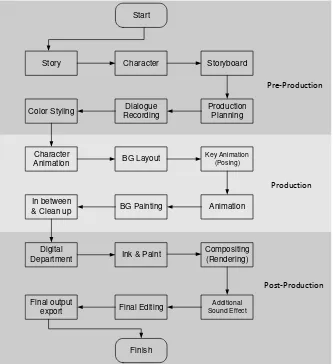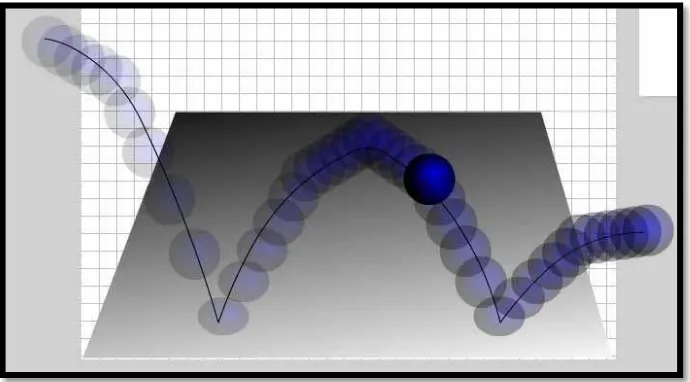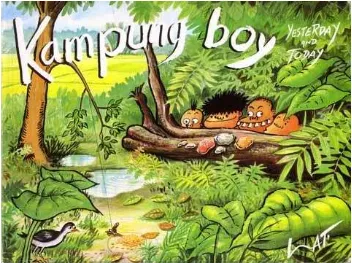COMPARISON OF CLASSIC AND MOTION TWEEN TECHNIQUES IN 2D ANIMATION GLOBAL WARMING
MOHAMAD IZZAT AFIFI BIN YASIN
BORANG PENGESAHAN STATUS TESIS*
JUDUL:
SESI PENGAJIAN: ____________________
Saya
mengaku membenarkan tesis Projek Sarjana Muda ini disimpan di Perpustakaan Fakulti Teknologi Maklumat dan Komunikasi dengan syarat-syarat kegunaan seperti berikut:
1. Tesis dan projekadalah hakmilik Universiti Teknikal Malaysia Melaka.
2. Perpustakaan Fakulti Teknologi Maklumat dan Komunikasi dibenarkan membuat salinan untuk tujuan pengajian sahaja.
3. Perpustakaan Fakulti Teknologi Maklumat dan Komunikasi dibenarkan membuat salinan tesis ini sebagai bahan pertukaran antara institusi pengajian tinggi. 4. ** Sila tandakan (/)
________ SULIT (Mengandungi maklumat yang berdarjah keselamatan atau kepentingan Malaysia seperti yang termaktub di dalam AKTA RAHSIA RASMI 1972)
________ TERHAD (Mengandungi maklumat TERHAD yang telah ditentukan oleh organisasi/badan di mana penyelidikan dijalankan)
________ TIDAK TERHAD
_________________________ (TANDATANGAN PENULIS)
__________________________ (TANDATANGAN PENYELIA)
Alamat tetap: __________________________ ___________________________ _____________________________________ Nama Penyelia
Tarikh: ______________________________ Tarikh: ____________________
CATATAN: * Tesis dimaksudkan sebagai Laporan Projek Sarjana Muda (PSM).
** Jika tesis ini SULIT atau atau TERHAD, sila lampirkan surat daripada pihak berkuasa.
MOHAMAD IZZAT AFIFI BIN YASIN
COMPARISON OF CLASSIC AND MOTION TWEEN IN 2D ANIMATION
2013 / 2014
No 274, Depan SMK Bandar Chiku, 18300 Gua Musang, Kelantan
En. Mohd Adili bin Norasikin
30/8/2013 30/8/2013
COMPARISON OF CLASSIC AND MOTION TWEEN TECHNIQUES IN 2D ANIMATION GLOBAL WARMING
MOHAMAD IZZAT AFIFI BIN YASIN
This report is submitted in partial fulfilment of the requirements for the Bachelor of Computer Science (Media Interactive)
FACULTY OF INFORMATION AND COMMUNICATION TECHNOLOGY UNIVERSITI TEKNIKAL MALAYSIA MELAKA
DECLARATION
I hereby declare that this project report entitled
COMPARISON OF CLASSIC AND MOTION TWEEN TECHNIQUES IN 2D ANIMATION GLOBAL WARMING
is written by me and is my own effort and that no part has been plagiarized without citations.
STUDENT : ________________________________ Date: (MOHAMAD IZZAT AFIFI BIN YASIN)
SUPERVISOR : _________________________________ Date: ____________ (EN. MOHD ADILI BIN NORASIKIN)
30/8/2013
iii
DEDICATION
Specially dedicated:
To my beloved parents and family member
For my supervisor, En. Mohd Adili bin Norasikin For my evaluators, En. Mohd Lutfi bin Dolhalit
ACKNOWLEDGEMENTS
I would like to thank to ALLAH SWT because give me a chance to live in this world to fulfil my project. I also would like to thank to all people who give me the great idea during learning session at Universiti Teknikal Malaysia Melaka majoring in Media Interactive.
Besides, I would like to thank to those who give me a complete support during my project research and development. Thank you also to all the lectures and staff for their kindness to give me knowledge to understand the process development of my project especially to my best supervisor En. Mohd Adili bin Norasikin and my best evaluator, En. Mohd Lutfi bin Dolhalit who give me an enough support to fulfil this project. All the kindness and support will be appreciated.
v
ABSTRACT
ABSTRAK
vii
TABLE OF CONTENTS
CHAPTER SUBJECT PAGE
DECLARATION ii
DEDICATION iii
ACKNOWLEDGEMENTS iv
ABSTRACT v
ABSTRAK vi
TABLE OF CONTENTS vii
LIST OF TABLE x
LIST OF FIGURE xi
LIST OF ABBREVIATIONS xiii
CHAPTER I INTRODUCTION 1.1 Project Background 1
1.2 Problem Statements 2
1.3 Objectives 3
1.4 Hypothesis/Research Questions 3
1.5 Scope 4
1.6 Project Significance 5
Summary 5
2.2 Current System/Tools/Output 8
2.3 Comparison of Existing System 11
Summary 12
CHAPTER III METHODOLOGY 3.1 Research Activities 13
3.1.1 Data Gathering 14
3.1.2 Analysis of Data 14
3.2 Product Development Methodology 19
3.2.1 Multimedia Production Process 19
3.2.1.1 Pre-production 20
3.2.1.2 Production 21
3.2.1.3 Post-production 22
3.3 Project Requirements 22
3.3.1 Hardware Requirement 23
3.3.2 Software Requirement 23
3.4 Gant Chart / Mile Stone 23
Summary 24
CHAPTER IV ANALYSIS 4.1 Requirement Analysis 26
4.1.1 User Requirement 26
4.1.2 System Requirement 27
4.1.3 Hardware Requirement 29
Summary 30
CHAPTER V DESIGN AND IMPLEMENTATION 5.1 Design/Product Process 32
5.1.1 Design Architecture 32
5.1.2 Product Development Process 33
5.2 Design/Product Implementation 39
5.2.1 Design / Product Integration Process 41
ix
CHAPTER VI TESTING AND EVALUATION
6.1 Test Plan 43
6.1.1 Test User 44
6.1.2 Test environment 44
6.1.3 Test Schedule 45
6.1.4 Test Strategy 45
6.2 The Implementation Process 46
6.2.1 Test Description 47
6.3 Test Results and Analysis 49
6.3.1 Analysis Testing 51
Summary 55
CHAPTER VII CONCLUSION 7.1 Observation on Strengths and Weaknesses 56
7.2 Propositions for Improvement 57
7.3 Contribution 57
7.4 Future Work 58
REFERENCES 59
APPENDICES 60
Appendix A Milestones 60
LIST OF TABLES
TABLE TITLE PAGE
4.1 Analysis of Hardware Requirement 29
6.1 Hardware and Software Minimum Requirement for Testing Environment
44
6.2 Testing Schedule 45
6.3 User Background testing result 50
xi
LIST OF FIGURES
FIGURE TITLE PAGE
1.1 Project Framework 4
2.1 Tweening with multiple frames 8
2.2 Screenshot of Kampung Boy 9
2.3 Screenshot of Bola Kampung 10
2.4 3.1
Screenshot of Supa Strikas Analysis result for question 1
11 15
3.2 Analysis result for question 2 15
3.3 Analysis result for question 3 16
3.4 Analysis result for question 4 17
3.5 Analysis result for question 5 17
3.6 Analysis result for question 6 18
3.7 Multimedia Production Process 19
5.1 Design Architecture 33
5.2 5.3
Design of character Bird Design of forest from above
5.4 Design of forest area 37
5.5 Design of factories area 37
5.6 Design of suburbs area 38
5.7 Design of North Pole 38
5.8 Design of residential area 39
6.1 6.2
Questionnaire Part I: User Background Questionnaire Part II: Animation
48 49
6.3 User Background Testing Result 52
6.4 Animation Testing Result question 1 - 4 53
xiii
LIST OF ABBREVIATIONS
PSM - Projek Sarjana Muda
OS - Operating System
SDLC - System Development Life Cycle FLA - Flash Data File Extension PSD - Photoshop Data File Extension RAM - Random-Access Memory CPU - Central Processing Unit SWF - Shockwave Flash
CHAPTER I
INRODUCTION
This chapter is a beginning section which states the purpose and goals of the project. The introduction may describes the project background, problem statement, objective and scope of the project and gives the brief explanation and summary of the project.
1.1 Project Background
2
In traditional cartoon animation, the individual frames the film was initially drawn on thin onionskin paper over the light source. Animators will put previous and next drawings right on the working drawings, so that they can draw 'in between' to provide smooth motion. Now days, 2D animation is booming so much so that a variety of facilities and techniques have been introduced. Among the well-known technique in making animation is tweening techniques. "Tween" is actually an acronym for "in between", and referring to creation of the succession frames of animation between key frames. In computer animation, the term is usually used for Flash is "classic tweening" and "motion tweening" techniques. From this techniques, animators can define at least two key frames and it will automatically create in-between frames, whether morphing one shape to another over set period of time or the other to move the form or shape from point A to point B in a set period of time. In 3D animation programs, they also have their own method of "tweening".
For this project, tweening techniques will be used which is a very effective way to create smooth movement and comparison between two tweening technique which is classic tween and motion tween will be made by two animation with same storyline(Global Warming), same character and same keyframe, but different techniques.
1.2 Problem Statement
Flash Pro is well known software to produced 2D animation especially to 2D animators or 2D artists’ which is widely used around the world. Flash Pro supports some techniques for creating animation and techniques that commonly used is classic tween and motion tween which is two different types of tweens.
between classic and motion tween. Both tween techniques have their own advantages and disadvantages. By motion tween, it allows great control over tweened animation while the classic tween, it covers all tweens created in earlier versions of Pro, which is greater complex to create. Although Motion Tweens offers greater control of a tween, classic tween provide particular specific capabilities that some users need.
1.3 Objective
To develop a 2D animation with tweening techniques.
To measure user reaction in 2D animation with tweening techniques.
To investigate the comparison between classic and motion tween in context of content and quality.
1.4 Research Questions
Which of the two techniques is suitable for developing the 2D animation? Classic tweening or motion tweening?
How to produce 2D animation with tweening techniques?
4
1.5 Project Scope
Developing the 2D animation by applying the classic and motion tween techniques.
Duration of this animation is 3 minutes
Software that will be used is Flash Professional CS6 The target audience is beginner animator.
1.6 Project Framework
Story Character Storyboard
Production Planning Color Styling
Character
Animation BG Layout
Dialogue Recording Key Animation (Posing) Animation BG Painting In between & Clean up
Digital
Department Ink & Paint
[image:19.595.125.458.370.734.2]Compositing (Rendering) Additional Sound Effect Final Editing Final output export Start Finish
Figure 1.1 Project Framework
Pre-Production
Production
1.7 Project Significance
This project will help the animators in deciding to choose which tween technique is more suitable to be used in animation that will be developed. In addition, this project will also provide a lot of information about the motion tween and the classic tween.
Summary
6
CHAPTER II
LITERATURE REVIEW
The literature review is a summary of the existing literature or published material. It is also to evaluate the information found in the research report of literature related to the study area. It is intended to do research and expanding a particular knowledge on an ongoing basis. Literature that can be used which include journal articles, Internet (electronic journals) books, Newspapers, magazines and thesis. For this project, some literature review that associated with project title will be used.
2.1 Area of Study
move an object, apply fade, and gradually change color, alpha, scale, and any other effects that can be applied to an object symbol, group, or text.
Flash use two different types of motion tweens: classic tween and motion tween. A classic tween uses several instances in keyframes of an object along with property keyframes to create a tween, while a motion tween uses one object instance over the entire span along with property keyframes to create a tween. A property keyframe is a frame within the motion tween where you define a value for a property. A motion tween is known as object based animation.
2.1.1 Tweening Technique
Tanita Suepa (2011), “I prefer tweening. It is powerful animation features that can generate transition images between keyframes. Tweening makes gradual changes to map animation so an animation looks smooth. Furthermore, it is easy for user to detect the change between scenes. Another significant benefit of using tweening is to reduce change blindness. With these characteristics, tweening is more effective than tween less. However, the disadvantage of tweening are time consuming.”
8
Figure 2.1 Tweening with multiple frames.
However, Tom Green and Jordan L. Chilcott (2010) said, the first thing that catches an animators’ attention is the capability in Flash to tween objects. Essentially, a tween is Flash automatically drawing the changes in shape or location of objects on the Stage. Done properly, tweening will be a huge timesaver. If done incorrectly, you will find yourself contending with choppy animation and rather large file sizes.
2.2 Current Systems/Tools/Output
Figure 2.2 Screenshot of Kampung Boy


